Lakeside Resort
Wildflower Information
Due to the abundance of Tennessee native wildflowers found growing on our grounds, spring through fall is always an exciting time for us. Our wildflowers first start appearing around late February and continue their magnificent show into late October. With the widely diverse growing conditions; from open meadows to deep shaded woods to lakeshore banks, the variety of wildflowers found is unmatched in the Middle Tennessee area. Lakeside Resort is spread across 139 acres and includes some great trails with breathtaking overlooks of Center Hill Lake. Bring your camera and come explore with us. For the best shots, early morning and late evening provide the best natural light, why not call and book a wildflower weekend with us - 888-839-4799.
The wildflowers listed below are in the general bloom sequence in which they were found.
Please enjoy our wildflowers - but please leave them for others to enjoy as well. It is illegal to collect species found at and around Lakeside Resort. You may purchase many of these species from reputable nurseries in our area.
![]()
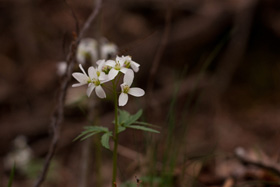 Dentaria lacinata - Cut-leaf Toothwort - March 24
Dentaria lacinata - Cut-leaf Toothwort - March 24
Height: 4-8" tall - Perennial
Blooms: March to April
Flowers: white, sometimes pink
Habitat low woods, slopes, ravines
Photographed: Upper Lake Trail
One of the first plants to bloom in spring. The presence of this species indicates that its soil has never been plowed under or subjected to heavy activities.
Mouse over Image - This is actually a mass of Toothworts, Rue Anemones, and Virginia Spring Beauty. Also in this open woodland are Fire pinks, Phlox, Yellow Violets, Red Trillium and many other assorted wildflowers. There is no trail through this area, so it is slow walking, but well worth it.
![]()
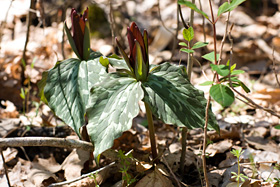 Trillium cuneatum - Red Trillium - March 24
Trillium cuneatum - Red Trillium - March 24
Height: less than 6" - Perennial
Blooms: March to April
Flowers: maroon
Habitat: rich, moist woods
Photographed: Upper Lake Trail
This Trillium has a very interesting fragrance, but since it such a low grower you will have to get your knees dirty to enjoy (well worth it).
Mouse over image - This small patch appeared at our Amphitheater overlook. Included with the trillium are a blanket of Blue Violets cascading down the bank.
![]()
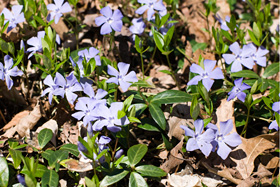 Vinca minor - Periwinkle, Not a Native - March 24
Vinca minor - Periwinkle, Not a Native - March 24
Height: up to 6" - Perennial
Blooms: March to April
Flowers: violet to blue
Habitat: open to shady forests
Photographed: Woodland Roadside Walk
This plant is actually considered an invasive exotic pest and shouldn't even be included on this page! But at Lakeside Resort, we have areas blanketed with Vinca minor and unfortunately it is beautiful when in full bloom. The problem with Vinca minor, crowds out true native plants with its dense, matting habit.
Mouse over image - From this image you can see the matting nature of Vinca when not kept under control.
![]()
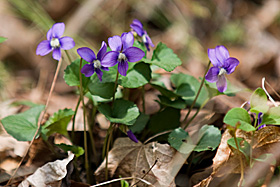 Viola sororia - Common Blue Violet - March 31
Viola sororia - Common Blue Violet - March 31
Height: up to 3"
Blooms: March to June
Flowers: violet to blue
Habitat: woods, meadows
Photographed: Upper Lake Trail
Watch where you walk with these little guys, they have a habit of popping up where ever and when ever they get the urge. For some reason the smaller they are the dirtier one gets trying to get them to pose for photos.
Mouse over image - This patch reminds me of a book series I loved while growing up as a child "The Foxfire Book". It was "a memorial to the people and the vanishing culture of the Southern Appalachian Mountains". In this book, one of the many interesting things the Appalachian people did with wild violets was to make candy for their children (actually tasty!). I still have those books and enjoy thumbing through them on occasion.
![]()
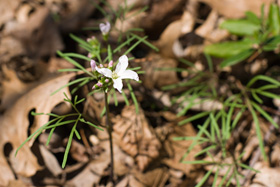 Dentaria multifida - Fine-leaf Toothwort - March 31
Dentaria multifida - Fine-leaf Toothwort - March 31
Height: 4-8" tall - Perennial
Blooms: March to April
Flowers: white to sometimes pink
Habitat low woods, slopes, ravines
Photographed: Upper Lake Trail
The leaves are much more finely cut than other species of Toothworts. It doesn't matter where you walk around Lakeside Resort these Toothworts and their close cousins can be spotted.
![]()
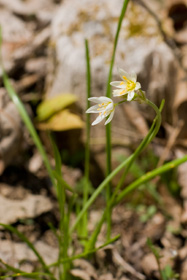 Nothoscordum bivalve - False Garlic - March 31
Nothoscordum bivalve - False Garlic - March 31
Height: 4 - 15" tall - Perennial
Blooms: March to May and sometimes in the fall
Flowers: white
Habitat: Open woods, fields
Photographed: Woodland Roadside Walk
I had to call in The University of Tennessee Herbarium to help Identify this one. I assumed it was a member of the Allium family with the true onions and garlic's, but it wasn't, hence the name False Garlic. While looking up the information on this plant I came across this little tid-bit - "Warning: all parts are poisonous and should not be tasted". I like the other common name it goes by - Crowpoison, I think that pretty much says it all.
![]()
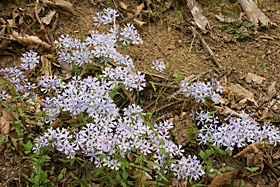 Phlox divaricata - Blue Phlox - April 5
Phlox divaricata - Blue Phlox - April 5
Height: 8-18" tall
Blooms: March to April
Flowers: blue, lavender, or pink
Habitat: woods, slopes
Photographed: Woodland Roadside Walk
Our grounds can be covered in this Blue Phlox if you time your visit just right! These are very fragrant and attack* Butterflies.
*attracts - Wife 1 / Spell Checker 0
![]()
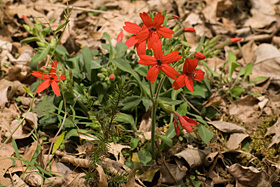 Silene virginica - Fire Pink - April 5
Silene virginica - Fire Pink - April 5
Height: 1 - 1.5' tall
Blooms: March to May
Flowers: brilliant red
Habitat: rocky meadows, steep slopes
Photographed: Woodland Roadside Walk
This is another one that just covers our grounds in mass. The Fire Pink is one of the few red flowering spring natives for our area.
Mouse over image - This image is from the same open woodland as the first image, Cut-leaf Toothwort. These patches of wildflowers can best be seen and photographed by just walking along Lakeside Resort's main entrance going to the office.
![]()
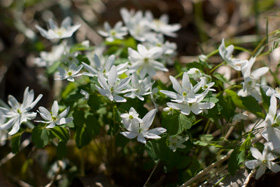 Thalictrum thalictroides - Rue Anemone - April 5
Thalictrum thalictroides - Rue Anemone - April 5
Height: 4-8" tall - Perennial
Blooms: March to April
Flowers: white
Habitat: dry to moist woods, edges
Photographed: Woodland Roadside Walk
These can be found growing in pockets along our drives and in the open woods. Because of their long stems they just seem to float in the wind, for this reason they are also referred to as wind-flowers.
Mouse over image - Although not a large patch, these appear in multiple, spreading clusters across the open woodlands.
![]()
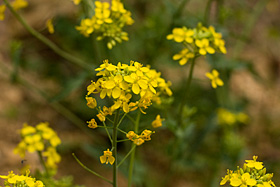 Senecio anonymous - Southern Ragwort - April 5
Senecio anonymous - Southern Ragwort - April 5
Height: 1-2' tall - Perennial
Blooms: March to April
Flowers: yellow
Habitat: roadsides, rocky slopes
Photographed: Upper Lake Trail
These Ragworts are an electric yellow and pop-up all long the rocky sides of our roads.
Mouse over image - This is a good example of what you can find blooming just by walking along our beautiful roadways. Included in this image is Vinca minor, violets, and a mature Redbud blooming in the background.
![]()
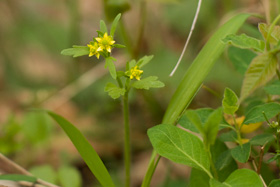 Ranunculus species - Buttercup - April 7
Ranunculus species - Buttercup - April 7
Height:
Blooms: April
Flowers: Yellow
Habitat:
Photographed: Upper Lake Trail
There are 93 species in Ranunculus, so when I asked for help to identify this one, The University of Tennessee Herbarium responded with just "Ranunculus sp.". I understand why now after trying to peg down the exact species from this image I sent them.
![]()
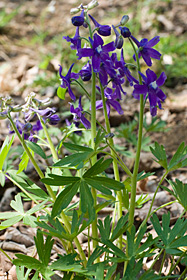 Delphinium tricorne - Dwarf Larkspur - April 9
Delphinium tricorne - Dwarf Larkspur - April 9
Height: .5 - 2' tall
Blooms: April
Flowers: Dark Blue
Habitat: moist, dappled shade, woodland slopes
Photographed: Backside of Lodge
This guy popped up right outside my office, soon followed by his friends. Leaving Lakeside Resort later that day I began to noticed large patches of them on the drive out.
Mouse over image - This patch is on the side of our drive by the gates, located half way down the main entrance. Early morning in the shade, the deep rich color combination was fantastic. In the background is a patch of Southern Ragwort.
![]()
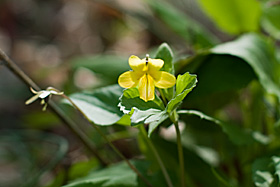 Viola pubescens - Yellow Woodland Violet- April 9
Viola pubescens - Yellow Woodland Violet- April 9
Height: 6-16"' tall - Perennial
Blooms: April to May
Flowers: Yellow
Photographed: Woodland Roadside Walk
I have not seen to many of these around our grounds, but since they prefer dry areas I can see why. This one was found in a very rocky, sloped area where the rain runs off very quickly.
![]()
 Claytonia virginica - Virginia Spring Beauty - April 9
Claytonia virginica - Virginia Spring Beauty - April 9
Height: 3-6"' tall
Blooms: April to May
Flowers: light pinkish tinge
Habitat: dappled woodland sunlight, moist to slightly dry soil
Photographed: Woodland Roadside Walk
The flowers are open and upright on sunny days but on cloudy days they droop and close. What they do at night is their own business.
![]()
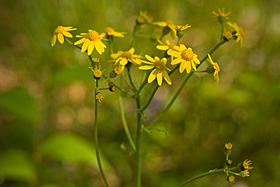
Senecio aureus - Golden Ragwort - April 14
Height: 1-2' tall
Blooms: April and May
Flowers: yellow
Habitat: Woods
Photographed: Woodland Roadside Walk
I probably would have added these earlier but assumed they were their Southern cousins, which bloom earlier. The leaves of the Senecio species are poisonous to humans, cattle, goats, horses, and other animals.
![]()
 Podophyllum peltatum - Mayapple - April 14
Podophyllum peltatum - Mayapple - April 14
Height: 1-1 1/2' tall - Perennial
Blooms: April
Flowers: White
Habitat: damp woodlands, shade to part shade
Photographed: Woodland Roadside Walk
This plant only has 2 leaves and 1 flower with all parts being poisonous except for the fruit. This is another wildflower that I read about in "The Foxfire Book" and of course, I had to try the fruit. It was bland, not sour, not sweet - but bland. I guess that's why the early settlers would make jam with it.
Mouse over image - Mayapple's will be found growing in colony's and spread by rhizomes. The actual color of their leaves is a much richer, deeper green.
![]()
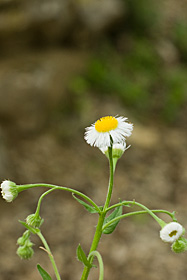 Erigeron philadelphicus - Common Fleabane - April 14
Erigeron philadelphicus - Common Fleabane - April 14
Height: 1 1/2' tall - Biennial, Perennial
Blooms: April - June
Flowers: white
Habitat: disturbed sites, roadways, open woods
Photographed: Woodland Roadside Walk
This one is considered an invasive weed by many - what do they know! This same species may be found with pink ray flowers. Common Fleabane has hairy stems and clasping leaves where its close cousin Lesser Fleabane - Erigeron strigosus doesn't. This plant was used to make a diuretic tea, it was also used to treat kidney stones and other ailments by our early settlers.
Mouse over image - As you can see from this image, they like hanging out along our roadsides. Fleabanes may also be spotted along the edges of our leisure walking trails.
![]()
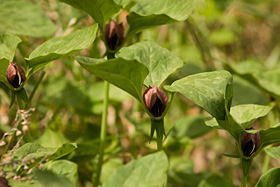 Trillium recurvatum - Prairie Trillium - April 19
Trillium recurvatum - Prairie Trillium - April 19
Height: 6-12" tall - Perennial
Blooms: April - May
Flowers: brown
Habitat: light shade or dappled sunlight, moist rich soil
Photographed: Woodland Roadside Walk
I was surprised to find these growing in large colonies as this trillium is a treat for deer - and we have the deer! The seeds are often distributed by ants due to the sweet, fleshy seed coating - elaiosomes, had to look that one up:)
![]()
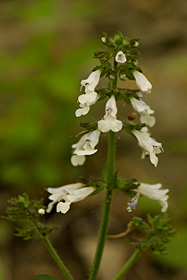 Salvia lyrata - Lyre-leaf Sage - April 19
Salvia lyrata - Lyre-leaf Sage - April 19
Height: 1-2' tall - Perennial
Blooms: April - June
Flowers: light blue
Habitat: open woods
Photographed: Woodland Roadside Walk
This is another one that I spotted on my drive in to Lakeside Resort. It is a member of the mint family but has no scent. It makes for an excellent evergreen ground cover due to the low growing purple-tinged leaves, and it reseed's easily, it can be walked on and mowed over, plus it puts on a long blooming show. The lower lip is a great landing pad for bees. When the bees land, the weight tips the flower downward and covers the bee in pollen.
![]()
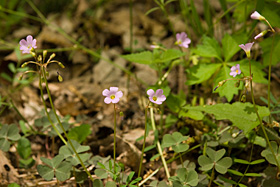 Oxalis violacae - Violet Wood Sorrel - April 19
Oxalis violacae - Violet Wood Sorrel - April 19
Height: 6" tall - Perennial
Blooms: April - May
Flowers: pink, light violet
Habitat: open woods, roadsides
Photographed: Woodland Roadside Walk
This patch was along our road and I spotted them after shooting the sage. To be more concise - I noticed them after photographing the Salvia lyrata. The leaves and flowers open on sunny days but fold up with cloudy skies or darkness. After a cold spell the leaves will show a purplish pattern and are quite striking. Since it is such a small plant with the leaves at ground level, they are usually smothered out by other plants as spring progresses.
![]()
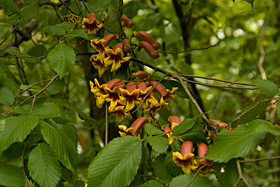 Bignonia capreolata - Cross Vine - April 19
Bignonia capreolata - Cross Vine - April 19
Height: 35-50' - Vine
Blooms: April - May
Flowers: maroon with yellow throat
Habitat: Trees, fence rows
Photographed: Woodland Roadside Walk
I thought I knew what this was, just another Trumpet Creeper, wrong! Trumpet Creepers don't start blooming until June. But it is in the Trumpet Creeper family as I found out from Beth at Mary's Greenhouse in McMinnville, TN. This Cross Vine can be found right before you drive down to our boat trailer overflow lot.
![]()
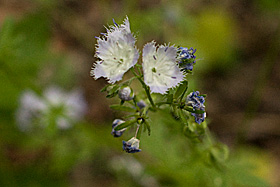 Phacelia purshii - Miami Mist - April 20
Phacelia purshii - Miami Mist - April 20
Height: 6-20" - Annual
Blooms: April - June
Flowers: Blue, Violet
Habitat: moist woods and fields
Photographed: Upper Lake Trail
Yet another surprise, these little lacy delights were just waiting for me. Right beside where I always park my car for the Upper Lake Trail. Just goes to show what nature can do in just a couple days time.
![]()
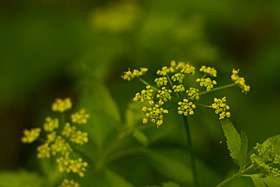 Thaspium barbinode - Hairy Meadow Parsnip - April 20
Thaspium barbinode - Hairy Meadow Parsnip - April 20
Height: up to 3 1/2' - Perennial
Blooms: April - June
Flowers: Yellow
Habitat: rich woods, rocky slopes, and woods
Photographed: Upper Lake Trail
A member of the carrot family and is found along the Highland Rim into most counties of East Tennessee. Once again, I almost got fooled into thinking it was a ragwort when walking by. Slow down and smell the flowers - or at least take the time to look a little closer.
![]()
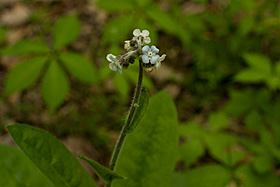 Cynoglossum virginianum - Wild Comfrey - April 20
Cynoglossum virginianum - Wild Comfrey - April 20
Height: 1 1/2 to 2 1/2' - Perennial
Blooms: April - May
Flowers: Pale Blue
Habitat: rich woods, rocky slopes, and woods
Photographed: Upper Lake Trail
These are the ones to blame! After a nice quite walk in the woods, you get home, take off your boots and what do you find stuck all in your socks? Little tiny barbed, well imbedded seed heads. This plant is a freak of nature, large hairy leaves with tiny blue flowers. Pretty aren't they - until they turn on you!
Mouse over image - I bet you recognize them now! See how they just lean out as to grab hold of your socks!
![]()
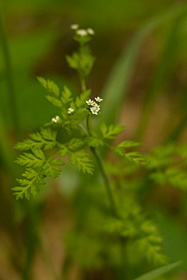 Chaerophyllum tainturieri - Southern Chervil - April 20
Chaerophyllum tainturieri - Southern Chervil - April 20
Height: 1 1/2' - Annual
Blooms: April - May
Flowers: White
Habitat: Rocky Shady areas
Photographed: Upper Lake Trail
Yet another plant that spreads its' seeds by hitching a ride. But unlike those of the Wild Comfrey, these are easily picked off. A member of the Parsley family with the tiniest of flowers, it is the foliage that is most striking.
![]()
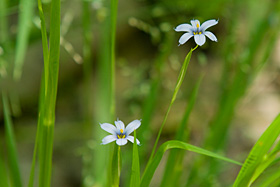 Sisyrinchium angustifolium - Blue-eyed Grass - May 4
Sisyrinchium angustifolium - Blue-eyed Grass - May 4
Height: 1 - 2' - Perennial
Blooms: May - June
Flowers: Pale Blue
Habitat: Open woods, fields, and grassy roadsides
Photographed: Upper Lake Trail
Although the foliage resembles grass it is actually a member of the Iris family. How's that for a fun fact? This is a great groundcover due its attractive clumping habit and bloom period. The flowers are short lived but the plant itself is a repeat bloomer providing several weeks of flowers.
![]()
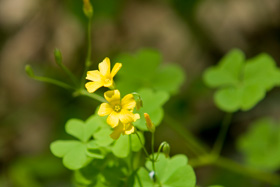 Oxalis stricta - Yellow Wood Sorrel - May 4
Oxalis stricta - Yellow Wood Sorrel - May 4
Height: 1 - 2' - Perennial
Blooms: May - October
Flowers: Yellow
Habitat: Rocky and open woods, fields, and roadsides
Photographed: Upper Lake Trail
These nice little yellow flowers are accused of being weeds by some. So I venture to guess that if one doesn't maintain one's estate properly, one would have to call them weeds. Anyway, the leaves of this plant has a slightly sour taste and adds a nice flavor to salads. The leaves can also be used to make a drink that is similar in taste to lemonade. But consume in moderation, Wood Sorrel contains high amounts of potassium oxalate and oxalic acid which can effect the kidneys. Another use for this "weed" - orange dye can be obtained by boiling the whole plant. Read more about the benefits of this great plant at www.kingdomplantae.net
![]()
 Trifolium pratense - Red Clover - May 4
Trifolium pratense - Red Clover - May 4
Height: 1 - 2' - Biennial, Perennial
Blooms: April - September
Flowers: Pinkish-purple (Red!)
Habitat: Fields and roadsides
Photographed: Woodland Roadside Walk
This is another one that is so beneficial to us but yet is also accused of being a weed. Red Clover is considered excellent forage for livestock and poultry and has over 60% more digestible protein as alfalfa. - The flowers are reported to possess antispasmodic, estrogenic, and expectorant properties. - Dry the flowers on paper in the shade and use in place of coffle or tea. - This plant also provides natural nitrogen to the farmer's fields and is heavily recommend by the people at your local AG station. But hey, don't take my word, read more from the people at Purdue University.
![]()
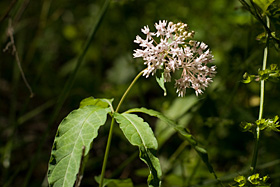 Asclepias quadrifolia - Four-leaved Milkweed - May 4
Asclepias quadrifolia - Four-leaved Milkweed - May 4
Height: 1 - 2.5' - Perennial
Blooms: May - July
Flowers: Light pink
Habitat: Rich or dry rocky open woods
Photographed: Woodland Roadside Walk
There are at least 10 varieties of Milkweed native to middle Tennessee so I thought this one would be a little harder to peg down. That is, until I noticed the set of 4 whorled leaves - dead give away.
![]()
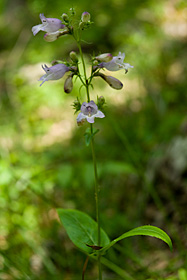 Penstemon calycosus - Beard-tongue - May 12
Penstemon calycosus - Beard-tongue - May 12
Height: 1 - 3' - Perennial
Blooms: May - July
Flowers: White or Pink
Habitat: rocky open woods, moist meadows within woodlands
Photographed: Woodland Roadside Walk
There is a small patch of Beard-tonges that has appeared along the main drive leading to the office. After getting back to the office and downloading the images, I found that there are two species growing in this patch. The one shown below has smooth, wide leaves where this one's leaves are narrower and serrated. These flowers have no scent and will bloom approximately one month. Highly recommended for wildflower gardens because of the bloom period and their beauty.
![]()
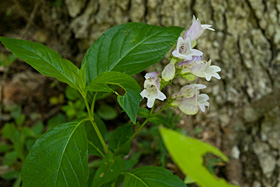 Penstemon laevigatus - Smooth Beard-tongue - May 12
Penstemon laevigatus - Smooth Beard-tongue - May 12
Height: 1 - 3' - Perennial
Blooms: May - July
Flowers: White or Pink
Habitat: rocky open woods, moist meadows within woodlands
Photographed: Woodland Roadside Walk
When I first came across this one it brought back some childhood memories. I would head out after cartoons on a saturday morning with shovel and backpack (before it was frowned upon) and collect wildflowers for the family garden. Apparently I didn't force this species into extinction as I still find them. One thing I noticed was that the Smooth Beard-tonge was a lighter pink then the Beard-tonge pictured above, could be due to the amount of shade.
![]()
 Trifolium aureum? - Golden Clover, Not a Native - May 12
Trifolium aureum? - Golden Clover, Not a Native - May 12
Height: up to 1' - Annual, Biennial
Blooms: May - July
Flowers: Yellow
Habitat: rocky open woods, moist meadows within woodlands
Photographed: Lower Lake Trail
I think I got this one right, there are 170 species of Trifolium listed with the USDA, so I apologize if I missed this one. The only reason I put this non-native up is due to the amount of time I spent narrowing it down and then only to find out its an import. I give this one the title "WEED", even if it is good forage for wildlife and has many other great benefits. Sorry, I've spent enough time already on this one to share the wealth of info I have obtained.
![]()
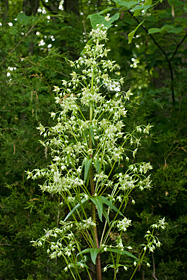 Frasera caroliniensis - American Columbo - May 12
Frasera caroliniensis - American Columbo - May 12
Height: up to 10' - biennial, actually a triennial
Blooms: April - May
Flowers: greenish white with purple spots
Habitat: rich open woods and dry areas especially in limestone soil
Photographed: Woodland Roadside Walk
I have been watching these guys since my first walk around Lakeside Resort last February. They started out with large, up to 18" long basal leaves, and just sat there. Then in April some of them sky-rocketed upwards and started developing the bloom head. Here it is mid May and some are just starting to bloom (triennials, three years to bloom), after its' bloom year the plant dies. The Colombo is "Rare in most of it's range, this unusual plant can be found in abundance in some areas of the limestone rich central basin of Tennessee." I have to thank the people at The University of Tennessee for helping me identify this one.
Mouse over image - This bloom is quite interesting, if you notice on each petal, 4 symmetrical pods contain the (male) stamens while in the center is a singular (female) pistil.
![]()
 Asclepias exaltata - Poke Milkweed - May 12
Asclepias exaltata - Poke Milkweed - May 12
Height: 2 - 6' - Perennial
Blooms: May - July
Flowers: greenish white with purple spots
Habitat: rich woods
Photographed: Lower Lake Trail
I almost missed this one and this is the only one I have seen so far. After reading about them however, I do expect to find more. But let it be known, this is one plant you don't want to ingest. "All parts toxic, only in large quantities". What's a "large quantity", that's what I'd like to know. OK, so here is where the research comes in - apparently Native American Indians would eat the root for stomach trouble, I'll stick with Tums. By the way, this is yet another plant that The University of Tennessee helped me out with. There ain't nothing like a VOL!!!
If you feel that any of the above are mislabeled or the info is incorrect, please contact me at bluton@uchra.com.